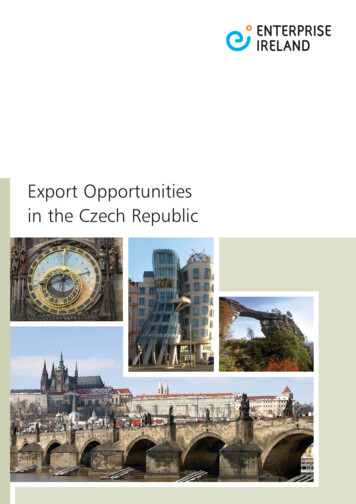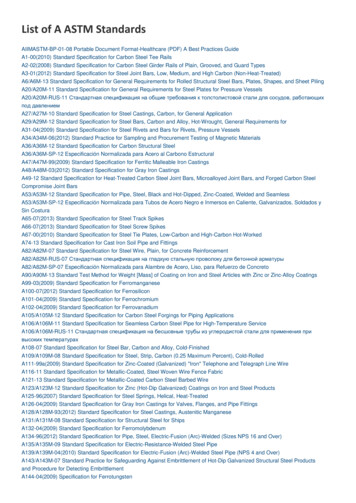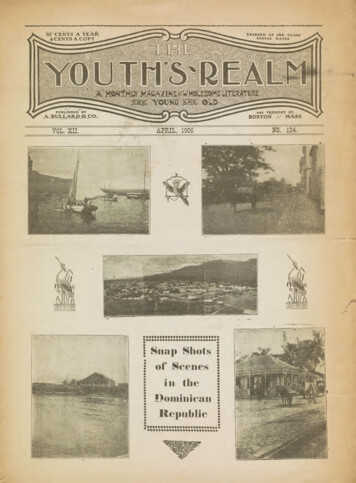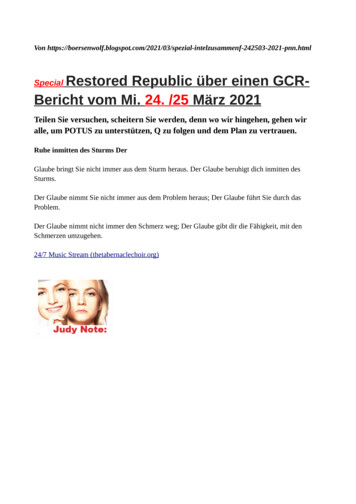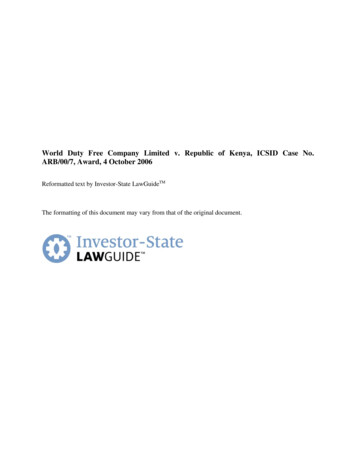
Transcription
THIS REPORT CONTAINS ASSESSMENTS OF COMMODITY AND TRADE ISSUES MADE BYUSDA STAFF AND NOT NECESSARILY STATEMENTS OF OFFICIAL U.S. GOVERNMENTPOLICYRequired Report - public distributionDate: 12/26/2017GAIN Report Number: DR1717Dominican RepublicExporter GuideOpportunities Abound for U.S. Consumer-Oriented ProductsApproved By:Lisa Ahramjian, Agricultural AttachéPrepared By:Mayra Carvajal, Agricultural Marketing SpecialistReport Highlights:In 2016, the Dominican Republic was the fifth-largest market, valued at almost 484 million, for U.S.consumer-oriented products in the Western Hemisphere after Canada, Mexico, Colombia, and Chile.The U.S.-Dominican Republic-Central America Free Trade Agreement (CAFTA-DR) has improved thecompetitiveness of U.S. products; consumer-oriented product sales have increased by 200 percent sincethe implementation of the agreement in 2007. The United States is the largest consumer food exporterto the Dominican Republic, with a market share of approximately 50 percent. With a very activetourism sector valued at approximately 5.3 billion in 2016 (representing 7.8 percent of the GDP), thereare opportunities for increased U.S. exports to the Dominican market. Products with the highestpotential include snack foods, powdered milk, wine, craft beer, and cheddar cheese.Post:Santo DomingoPage 1 of 24
SECTION I. MARKET OVERVIEW1.1. Economic situationAccording to the Dominican Republic Central Bank, the Dominican Republic (DR)’s gross domesticproduct (GDP) grew by 6.6 percent in 2016. This growth has positioned the DR as a leader in LatinAmerica for the third consecutive year, exceeding the expectations of the government and otherinternational institutions. This is especially notable because the International Monetary Fund (IMF)estimated Latin American’s GDP growth at -0.6 percent in 2016, mainly due to the economic situationin Brazil, Argentina, Venezuela, and Ecuador. The IMF has projected the DR’s GDP to increase 5.3percent in 2017.DR GDP Growth, 2012 - 2016In 2016, the main drivers of this growth were: mining (26.5 percent); financial intermediation (11.9percent); construction (9 percent); trade (6.5 percent); hotels, bars, and restaurants (6.4 percent);transportation and storage (5.6 percent); teaching (5.3 percent); and local manufacturing (5 percent).The agricultural sector grew 10 percent in 2016, recovering from last year’s drought.According to the Dominican Central Bank, the inflation rate in 2016 was 1.7 percent, which is thesecond-lowest rate in 33 years. While the inflation rate has dramatically decreased since 2012, it hadincreased moderately during 2015 due to price increases on locally-produced food and beverages (seefigure below). The inflation forecast for 2017 is 3.6 percent.Page 2 of 24
DR Inflation Rate, 2012 - 2016As of December 31, 2016, the exchange rate of the spot market for sales of U.S. dollars was1US 46.70RD .1.2. Demographics and income distributionAccording to the most recent census carried out by the National Office of Statistics (ONE) in 2010, theDR population was 9.4 million, with an annual growth rate of 1.21 percent. Of this total, men represent50.17 percent and women make up 49.82 percent. Approximately 75 percent of the population lives inurban areas and 25 percent lives in rural areas.The largest age cohort in the population isone between 15-19 years (10.4 percent),followed closely by 10-14 year-olds (10.3percent). Two-thirds of the population is35 years old (see graphic of the compositionDR population).theWith 3,339,410 people or 35.35percent ofpopulation, the city of Santo Domingo(including the National District, SantoDomingo province, and its surroundingsuburbs) is the largest market in the country.also the city with the highest populationdensity at about 2,396 inhabitants per squarekilometer (km2). Following the city of SantoDomingo, the largest markets in the DR are:Santiago province (population: 963,422;theunderof theIt’sPage 3 of 24
population density: 343 inhabitants per km21); San Cristobal province (population: 569,930; populationdensity: 459 inhabitants per km22); and La Vega province (population: 394,205; population density: 172inhabitants per km2). Other important provinces are La Romana, Bonao, San Francisco de Macoris, andHiguey. Higuey includes the most important tourist area of the country: the municipalities of Bávaroand Punta Cana.To study behavior trends, the Dominican Central Bank divides the population into 5 quintiles byincome; the income and purchasing power for these segments varies significantly as described below:Quintile1Description% of PopulationMonthlyaverageincome(US )198.632below thepoverty linelower class10% (944,528people)47% (4,439,282people)3middle class20% of thepopulation(1,889,056people)434.334upper middleclass17% (1,605,698people)671.905upper class6% (566,717people)1,599.77309.35Main Expenses andPercentage of Total ExpensesFood/non-alcoholic beverages:47.2%Food/non-alcoholic beverages:38.1%Transportation: 12.3%Housing: 9.4%This represents a good marketfor basic U.S. products such asbeans, poultry, rice, and bread.Food/non-alcoholic beverages:31.6%Transportation: 13.7%This represents a good marketfor U.S. high value products3Food/non-alcoholic beverages:24.8%Transportation for 13.7%Housing: 10.9%Hotels and restaurants: 9.5%This represents a good marketfor U.S. high value productsFood/non-alcoholic beverages:12.3%Transportation: 24.8%This represents a good marketfor U.S. high value products1The city of Santiago has a population of 591,985 and a population density of 3,587 habitants/ km 2.The city of San Cristobal has a population of 232,769 and a population density of 1,095 habitants/ km2.3 In this report Post refers as High Value Products to agricultural products with a level of processing either intermediate or consumeroriented.2Page 4 of 24
1.3. Market sizeBased on a 2007 survey (the most recent), approximately 21 percent of household expenditures werespent on food and non-alcoholic beverages. Within this category of expenses, the average Dominicanconsumes the following products:Monthly average expenses in food and non-alcoholic beverages in DRCategoryFood and non-alcoholic beveragesFood- Meat- Bread and cereals- Vegetables- Milk, cheeses and eggs- Fruits- Oils and fat- Foodstuff- Fish- Sugar, jam, honey, chocolate and sweetsNon-alcoholic beverages- Mineral water, refreshments, fruit and legumejuices- Coffee, tea and cocoaMonthly expensesAbsolute (US 689.353.8110.65Source: Built by FAS/Post with data from the National Poll of Household Income and Expenses, 2007. ONE.Post does not anticipate that these spending patterns will change significantly in the near future.Therefore, since the DR’s economy continues to develop and the population continues to increase, thegrowing demand of food products in the country presents opportunities for U.S exporters.From 2012 to 2016, the DR imported more than 12 billion in food and beverages, with approximately50 percent coming from the United States. In 2016, the DR imported 2.5 billion in agricultural andfood and beverages products, sourcing 1.26 billion of that from the United States. In comparison, thetotal U.S. exports of food and beverages to the DR in 2007 were 804 million; this highlights positiveimpact of CAFTA-DR for U.S. exports.Page 5 of 24
1.4. Advantages and challenges in the marketAdvantagesChallenges1. The implementation of CAFTA-DR, which haslowered or eliminated duties on nearly 80percent of products.2. A large and growing tourist population (6.0million in 2016), which demands high valuefood products.1. Competition from other CAFTA-DR signees andother countries that have signed free tradeagreements with the DR.2. Tariff rate quotas, safeguards and other CAFTA-DRprovisions that protect local producers of rice, meat(beef, poultry and pork), dairy products, beans,garlic, and onions.3. Requirement that U.S. products must comply withSpanish language labeling requirements.3. A growing number of consumers demandinghigher quality and healthier products; theygenerally perceive that U.S. products meet theirrequirements.4. Efficient food distribution channels, with theconstruction of new highways and themodernization of seaports and airportsfacilitating the flow of imported food products.5. Consumers greatly influenced by the U.S.culture, with a positive perception of U.S.products.6. The proximity of the DR to the United Statesand strong bilateral relationships throughout thepublic and private sectors, which facilitatestrade.7. Growing population in urban centers andincreased employment.8. A Dominican diaspora in the U.S. ofapproximately one million persons, clusteredprimarily in the northeastern states and Florida,whose remittance payments help support theDominican economy.4. Cold chain limitations.5. Require import permits for some products.6. 18 percent VAT and high internal logistic costs.7. Lack of transparency and corruption, which continueto earn the DR relatively low scores in internationalcomparison tables (DR was 99th out of 190 countriesin the World Bank’s 2018 “Ease of Doing Business”ranking).8. A lack of institutional continuity across changes ingovernment administrations.SECTION II. EXPORTER BUSINESS TIPS2.1. Business culturePersonal relationships are essential to building business relationships in the DR. In general, Dominicansattach great importance to courtesy in all business endeavors. A warm handshake combined withconversation about the person’s wellbeing, family, or other similar topics prior to launching into anyconversation related to business is considered a common courtesy. This communication helpsDominican businessman develop more confidence prior to any business commitment. Of course, asgenuinely warm and friendly as Dominicans are, every aspect of the business transaction should beclearly stated between the parties in writing.Page 6 of 24
The DR has few but persistent market access issues. A common market entry option is to appoint anagent or distributor in the DR; licensing agreements and franchises can also be successful. Because ofthe DR’s proximity to the United States and low air travel costs, the optimal market entry method isthrough a coordinated strategy that includes personally visiting potential partners or distributors in theDR. U.S. exporters should also be prepared to provide all promotional materials in the Spanishlanguage. Good after-sales service is a pre-requisite of doing business successfully in the country.2.2. Consumer tastes and preferencesDominicans have adopted a lot of U.S. culture, such as music, sports, entertainment, and fashion. DRfood consumption trends are similar to trends in the United States. While U.S. trends may take a fewyears to arrive in the DR, CAFTA-DR has accelerated this transfer. For example, in the middle classand above, consumers routinely visit U.S. fast food chains and restaurants established in the DR.Dominican consumers perceive that products made in more developed countries are more reliable interms of quality and safety. Additionally, higher income classes are demanding more natural andhealthy products, including those with less saturated fat, cholesterol, and sugar.2.3. Food Standards and Regulations (FAIRS)In general, food laws in the Dominican Republic have not substantially restricted trade for U.S.products. There are four government Ministries involved in setting food policy for the country: theMinistry of Public Health, the Ministry of Industry and Commerce, the Ministry of Agriculture, and theMinistry of the Environment and Natural Resources. The Ministry of Health plays a leading role withinthe Ministries.For more detailed information on how these Ministries interact and proceed, please refer to Post’s 2017Food and Agriculture Import Regulations and Standards (FAIRS) narrative report, DR1714.2.4. General import and inspection procedures2.4.1. Product registrationThe first step in importing new food products into the Dominican Republic is product registration.Importers register new food products with the Ministry of Public Health. The Ministry issues acertificate to the importer or the local legal representative with a Sanitation Registration Number, whichmust be printed on the label of the product or as an additional sticker.For more information, please refer to Post’s 2017 FAIRS narrative report (DR1714).Page 7 of 24
2.4.2. Customs clearanceThe General Directorate of Customs Office requires the importer to present the following documents torelease all shipments valued over US 100: Bill of Lading (English or Spanish)Commercial InvoiceInsurance Certificate issued by a local insurance companySanitary certificate issued by the origin countryNon-objection Certificate issued by the Ministry of Agriculture4Import Permit issued by the Department of Internal Taxes for alcoholic beverages onlyWhen importers have all of the required documents and no sanitary issues arise, the customs clearanceprocedure can be completed in twenty-four hours. The process has been streamlined in recent years dueto the implementation of electronic customs systems, which allows the importer to request permits andprocess other transactions online. However, importers usually hire a knowledgeable customs agent whoexpedites the process. Larger importers will have a customs agent within their company. After ten daysin port, shipping lines assess a daily charge for the use of their containers. Port authorities also chargefor the use of their space.After the invoice is reviewed, Customs officials determine the duty. If it is determined that the invoicedoes not reflect what Customs believes is an accurate price, Customs officials will review the duty basedon their own appraisal list (Lista de Valuación Aduanera, LVA). The actual product value may be lowerthan the o
26.12.2017 · Dominican businessman develop more confidence prior to any business commitment. Of course, as genuinely warm and friendly as Dominicans are, every aspect of the

